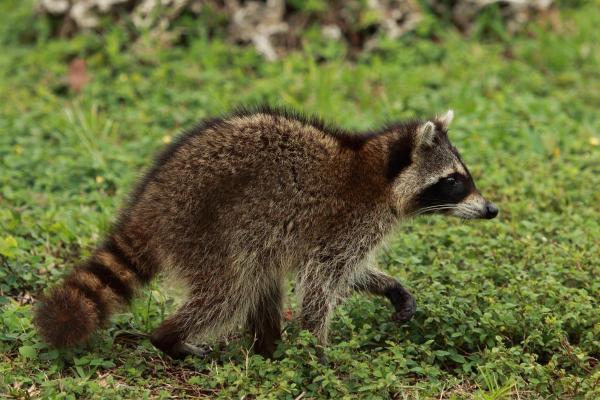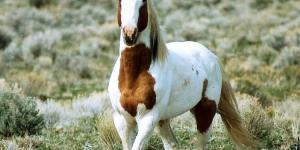Types of Raccoons Around the World


Raccoons are medium-sized mammals native to North and South America, easily recognized by their distinctive black facial mask and bushy, ringed tail. They are known for their intelligence, adaptability, and mischievous reputation. The exact number of raccoon species depends on classification. Some recognize seven distinct species, while others consider three main species with various subspecies.
In the following AnimalWised article, we will explore the three most popular types of raccoons and its main characteristics. Discover their unique adaptations, diets, and habitats, and learn how these clever mammals thrive across North and South America.
South American raccoon or crab-eater (Procyon cancrivorus)
Native to Central and South America, the South American raccoon (Procyon cancrivorus) is also known as the crab-eating raccoon. Unlike its North American cousin, this species boasts shorter, coarser fur. They're smaller as well, with a body length ranging from 21 to 26 inches and a tail adding another 10 to 15 inches. Despite their size, they can weigh between 6.6 and 15.4 pounds.
These resourceful omnivores are true opportunists. Their diet is a smorgasbord of fruits, nuts, crustaceans (including the namesake crabs, especially near coasts), insects, frogs, small turtles, fish, mollusks, and more. They adjust their diet based on what's available, relying more on fruits and insects during dry seasons.
Solitary creatures by nature, except for mothers raising their young, crab-eating raccoons are nocturnal. They spend their days tucked away in dens that are not of their own making. They cleverly utilize pre-existing shelters like tree hollows, abandoned termite mounds, or rocky crevices.
While their scientific name, "Procyon cancrivorus," translates to "dog-faced crab-eater," their taste for crabs isn't their only claim to fame. They're excellent swimmers and climbers, with well-developed thumbs on their front paws that aid in grasping food. Their diverse vocalizations, which include whistles, screeches, and even purrs, further set them apart from other species.
The South American raccoon currently holds a "Least Concern" conservation status. However, habitat loss due to deforestation and agriculture remains a threat. Additionally, some hunting for fur and illegal pet trade still occurs.

Common raccoon (Procyon lotor)
The common raccoon, also known as the North American raccoon (Procyon lotor), has a widespread distribution and is native to North America, including Canada, the United States, Mexico, and Central American countries such as Costa Rica, Belize, El Salvador, Guatemala, Honduras, Nicaragua, and Panama. Additionally, it has been introduced to several countries in Europe and Asia.
The common raccoon's intelligence and adaptability have allowed them to thrive in various habitats. They are found in forests, mountains, grasslands, and increasingly, urban areas where they have learned to exploit human waste for food. However, this adaptability can sometimes bring them into conflict with humans.
Easily identified by its black facial mask and ringed tail, the common raccoon has a stocky build with soft, grayish-brown fur. They are smaller than some might think, typically measuring 23-37 inches (58-94 cm) in body length with a tail adding another 10-16 inches (25-41 cm). Despite their size, they can pack a punch, weighing between 10 and 35 pounds (4.5-16 kg).
Primarily nocturnal animals, common raccoons are most active at night. Their excellent night vision allows them to navigate their environment and hunt for food when light levels are low. During the day, they seek shelter in dens located in trees, hollow logs, abandoned buildings, or even burrows.
While solitary for most of the year, females raise their young, called kits, alone. A litter can have 1-7 kits, which are born blind and helpless but develop quickly, becoming independent around 6 months old.
It is classified as Least Concern by the IUCN.
Ever wonder if raccoons make good pets? In our other article, we explore the pros and cons of having a raccoon as a pet.

Pygmy or Cozumel raccoon (Procyon pygmaeus)
The pygmy raccoon (Procyon pygmaeus) is endemic to Mexico and is found only on the island of Cozumel, off the Yucatan Peninsula. While there were initial doubts about its status as a distinct species, genetic studies have confirmed its classification.
Its habitat includes mangroves, sandy areas, tropical forests, deciduous forests, coastal areas, and fields of crops that include human settlements.
The most striking feature of the Cozumel raccoon is its small stature. Significantly smaller than its mainland cousin, the common raccoon, the Cozumel raccoon typically measures just 15-20 inches (38-50 cm) in body length with a tail adding another 8-12 inches (20-30 cm). Their weight reflects this diminutive size, with adults typically weighing only 3-5 pounds (1.4-2.3 kg). This size reduction, a phenomenon known as insular dwarfism, is thought to be an adaptation to the limited resources available on Cozumel Island.
Beyond size, the Cozumel raccoon exhibits several other physical adaptations that distinguish it from its mainland relatives. Their fur is typically buff-grey with occasional black hairs, offering a slightly different coloration than the common raccoon. Their snouts are shorter and rounder, and their teeth are slightly reduced in size, which may reflect a diet that differs somewhat from their mainland counterparts.
The pygmy raccoon is primarily nocturnal, but may occasionally be active during the day. It is an excellent climber, and like other raccoons, it is omnivorous, with a diet consisting of crabs (making up more than 50% of its food), other invertebrates, frogs, fruits, seeds, and flowers.
Cozumel raccoons are primarily solitary creatures, except during breeding season. Females typically give birth to a single litter of 2-4 kits per year. These kits are born helpless and rely on their mothers for care until they reach independence around 6 months old.
Unfortunately, the pygmy raccoon is classified as Critically Endangered due to habitat loss and degradation caused by tourism development on the island of Cozumel since 2005. This includes the construction of roads, habitat destruction, introduction of predatory species, intense hurricane seasons, and the spread of diseases due to introduced pathogens. These factors have had a severe impact on the species' survival.
There are many animals that look like raccoons but are not, read this other article to discover who they are here.

If you want to read similar articles to Types of Raccoons Around the World, we recommend you visit our Facts about the animal kingdom category.
- Baker, R. (2013). " Procyon pygmaeus ." Animal Diversity Web. Available at: https://animaldiversity.org/accounts/Procyon_pygmaeus/
- Cuarón, AD, de Grammont, PC & McFadden, K. (2016). Procyon pygmaeus . IUCN Red List of Threatened Species 2016. Available at: https://dx.doi.org/10.2305/IUCN.UK.2016-1.RLTS.T18267A45201913.en
- Fox, R. (2001). " Procyon lotor ." Animal Diversity Web. Available at: https://animaldiversity.org/accounts/Procyon_lotor/
- Reid, F., Helgen, K. & González-Maya, JF (2016). Procyon cancrivorus . IUCN Red List of Threatened Species 2016. Available at: https://dx.doi.org/10.2305/IUCN.UK.2016-1.RLTS.T41685A45216426.en
- Phillips, N. (2005). " Procyon cancrivorus ." Animal Diversity Web. Available at: https://animaldiversity.org/accounts/Procyon_cancrivorus/
- Timm, R., Cuarón, AD, Reid, F., Helgen, K. & González-Maya, JF (2016). Procyon lotor . The IUCN Red List of Threatened Species . Available at: https://dx.doi.org/10.2305/IUCN.UK.2016-1.RLTS.T41686A45216638.en.








